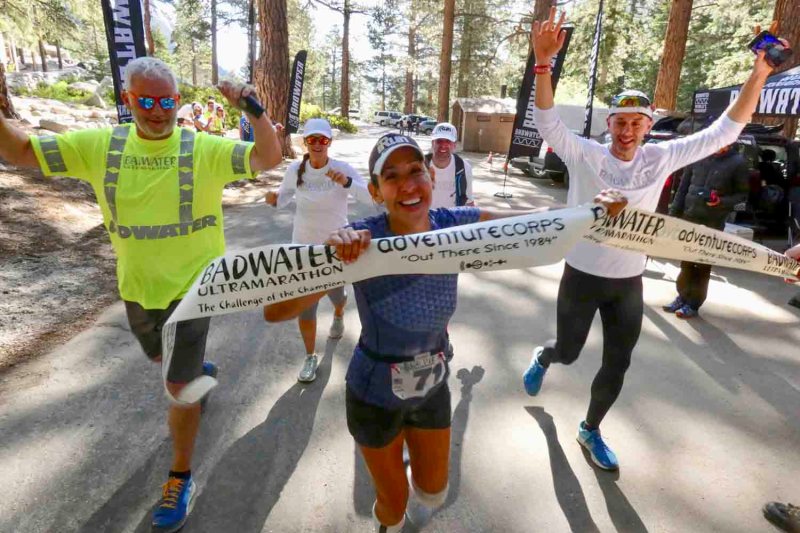
Think getting yourself back in shape is hard? Well, it can be, sure, but you can do it.
Now, do you think getting yourself into world-class ultra-marathon-winning shape is hard? Yeah, you’re right. But it can be done, too. And in the case of world record-holding ultra runner Caryn Lubetsky, she ran the first of her many, many races on the occasion of her 40th birthday. This was while balancing the other aspects of her life, including being a lawyer, a law professor, a high-school cross county coach, president of a parents’ association, and life long advocate for those in need, something she does primarily for The Childhood Cancer Project and her own foundation, HELP, the HIV Educational and Law Project.
Given her late start at running and the fact that in the eight years since Caryn began competing she has racked up an almost laughable number of appearances on the podium (to date the numbers are: 31 marathons, 5 100-mile ultra-marathons, 4 Ironmans, 3 50k ultra-marathons, 2 50-mile ultra-marathons, 2 12-hour ultra-marathons, and 2 6-hour ultra-marathons) we thought she just might be a good person to chat with about how to finally get yourself in shape, and how to get into great shape, at that.

CL: I grew up as a competitive swimmer so training and working out was always a part of my lifestyle, but I actually hated to run until much later in life. I think the best way to begin to get in shape is to call a friend, ask them to go for a long walk, short run, or class with you. Always start small, one class or 2-3 miles. If you go out and run 5 miles your first day you risk injury and you will be so sore that you [will be] much more likely to quit. Take it step by step. By asking a friend to meet you, turn the exercise session into a social activity and when you know someone is meeting you, you are much less likely to back out, sleep through, or simply blow off the workout.
TM: What advice do you have for keeping fit, especially during those periods where someone is not actively training for a specific event?
CL: Get out and walk! After dinner, take a 10-15 minute walk. It will help you digest, help you sleep better, and give you a chance to just wind down. Also sign up for a class or two that focuses on something outside of your comfort zone. If you are a runner sign up for a yoga class or spin session. Changing up the type of exercise you do helps combat boredom, which derails most exercise routines!
TM: What are some of your recommendations for diet and other lifestyle factors beyond the exercise itself?

CL: It sounds cliché, but everything in moderation. I am a very clean eater, but you have to allow yourself some leeway to splurge and try new things. I think any schedule that is too regimented leads to burnout so enjoy a day off of exercise, sleep in every once in a while and just simply give your self a break, don’t stress over one missed workout or one extra dessert, just focus and get back on track and enjoy the discipline as much and the diversion from it.
TM: What is the hardest race or other competition you have completed yet, and what made it such a challenge?
CL: Hands down it is Badwater135. I have pulled a person through 400 miles of triathlon in one week and nothing compares to the brutality and majesty of Badwater. The sheer distance, 135 miles, coupled with the heat — 125 degrees during the day, 110 at night — the 3 mountain ranges and 20,000 feet of climbing, coupled with the remote location truly make it the toughest foot race on the planet.
TM: What do you feel has been your greatest competitive success so far? And which race or other competition was simply the most fun?
CL: Setting a Guinness world record for pulling Kerry Gruson, a quadriplegic athlete, through 400 miles of triathlon was definitely a great deal of fun and excitement – we got to experience everything from freezing cold to hot humid weather, every type of terrain, road, sand, trail, and ocean, lake river and gulf swims, and closed and open road bike courses throughout our epic trek from Florida coast to coast. It was a grueling and gratifying experience.

TM: Tell us more about your work with The Childhood Cancer Project.
CL: When my good friend’s son was diagnosed in 2016 with osteosarcoma, I knew I had more work to do. Through the excruciating journey of having a sick child, my friend Joanna Segal founded The Childhood Cancer Project in order to raise money for childhood cancer research. I was shocked to learn that only 4% of national funds are allocated to childhood cancer research, and that there have not been new cancer therapies for children developed in 40 years. 40 years! We would never drive a car that is 40 years old, or even use a cell phone that is 4 years old, yet we are treating children with old therapies. I knew I wanted to help and the way I knew how to do this was through my running. Two years ago I ran in the Keys 100, a 100-mile ultra through the Florida Keys. My goal was to raise $1,000 per mile and I did it with every cent going to The Childhood Cancer Project. This year I ran it again and surpassed the goal.



